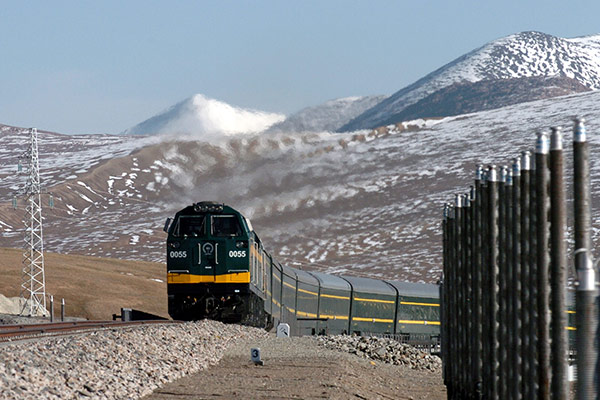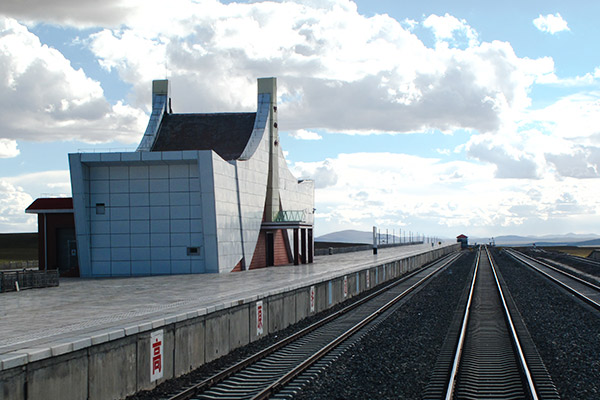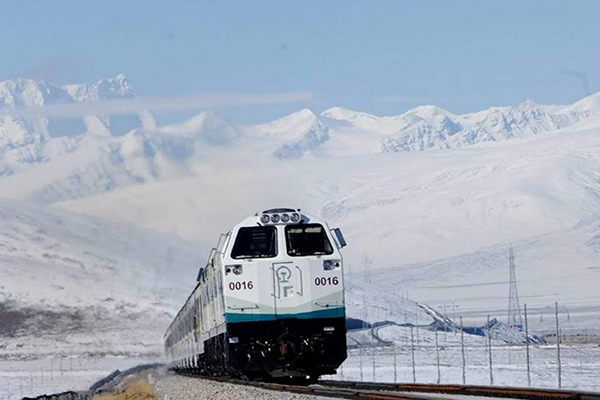World Records of the Qinghai-Tibet Railway: 7 Top Records and Facts
Operated since 2006, the Qinghai-Tibet Railway is a legendary route that starts in Xining, Qinghai Province, and ends in Lhasa, the capital of the Tibet Autonomous Region. It boasts several world records, including being the world’s highest railway, and offers the fastest train on frozen ground - the Tibet train.
Before taking your epic Tibet train journey, take a look at these top records of the Qinghai-Tibet Railway to discover why it’s so popular among tourists traveling to Tibet. Get inspired for your next adventure along this remarkable railway!
1. Qinghai-Tibet Railway is the Highest Railroad in the World
The biggest record held by the Qinghai-Tibet Railway is its title as the world’s highest railway. At its peak, the route soars to 5,072 meters as it crosses over Tanggula Pass. The pass lies on the border of Qinghai Province and the Tibet Autonomous Region, and is one of the highlights along the 1,956 kilometer stretch between Qinghai and Tibet.
Tanggula Pass’s high altitude smashed the previous record of 4,829 meters on the railway that runs across the Andes in Peru. In total, the Qinghai-Tibet Railway has more than 960 kilometers of track at altitudes above 4,000 meters. It set a new and still unbroken record for train travel at extreme elevations.
2. Qinghai-Tibet Railway is the Longest Plateau Railway in the World
The Qinghai-Tibet Railway is also the longest plateau Railway, covering a distance of 1,956 kilometers. The Tibetan Plateau is the largest in the world. It covers an area of 2.5 million square kilometers, making it a prime location for the record to be set. Nowhere else in the world is there a stretch of plateau that can match the 1,956 kilometers of rail of the Qinghai-Tibet Railway.
The record-breaking length lets you witness the amazing scenery of the ‘Roof of the World’. Across the plateau, you can see vast plains, snow-capped peaks, arctic lakes, and high-altitude mountain passes. The remote and majestic plateau landscapes can be enjoyed from the comfort and warmth of the train.
 Qinghai-Tibet Railway is the longest “plateau” railway in the world
Qinghai-Tibet Railway is the longest “plateau” railway in the world 3. Qinghai-Tibet Railway is the Longest Railway on Permafrost
Part of Tibet’s unique ecology is an extensive layer of permafrost that covers almost two-thirds of the plateau. The permanently frozen ground is a fragile layer that plays a crucial role in maintaining the plateau’s ecological balance and water systems. Protecting this important part of Tibet’s environment presented major engineering challenges.
Over 550 kilometers of track along the Qinghai-Tibet Railway are laid across the permafrost. The main section is between Golmud and Lhasa. Engineers overcame the environmental challenges using advanced techniques such as elevated tracks, ventilated embankments, and cooling pipes to keep the ground frozen and stable year-round. The result is the longest stretch of railway across permafrost in the world that manages to minimize the impact on the local ecosystem.
 Qinghai-Tibet railway running on the frozen ground in Kunlun Range
Qinghai-Tibet railway running on the frozen ground in Kunlun Range 4. Qinghai-Tibet Railway has the Highest Railway Station in the World
The Qinghai–Tibet Railway is home to the world’s highest railway station, Tanggula Railway Station, located at an altitude of 5,068 meters (16,627 feet) above sea level. Situated near the Tanggula Pass, this remote station lies on the border between Qinghai and the Tibet Autonomous Region.
It is a seldom-used station and unstaffed because of the extreme temperatures and altitude. The area around the station is sparsely populated, but it still covers a large area of over 77,000 square meters and stretches for 1.25km.
 Tanggula Station is the highest railway station in the world.
Tanggula Station is the highest railway station in the world.5. Qinghai-Tibet Railway is the First Railway to Connect Tibet with the Rest of China
Connecting Tibet to the rest of China by rail was a groundbreaking achievement of the Qinghai-Tibet Railway and its most long-lasting contribution. Before its full completion in 2006, access to Tibet was limited to air travel, rough overland roads, or long-distance bus journeys, which were often slow, weather-dependent, and logistically difficult.
The construction of the railway, particularly the Golmud–Lhasa section, filled a long-standing transportation gap and linked Tibet to China’s vast national railway network for the first time in history.
The railway has had a major impact on Tibet. By significantly lowering the cost and time of transportation, Tibetan people now have better access to a wider range of products and are able to more easily export local goods like yak meat, barley, and handicrafts. Cultural exchange has also been enhanced by allowing tourists to reach Tibet easily and by integrating Tibet with the rest of China and the world.
6. Qinghai-Tibet Railway Offers the Fastest Train on Frozen Earth
The Qinghai-Tibet Railway operates the Tibet trains on Frozen Earth, reaching speeds of 100-120 km/h, making it the fastest train to travel over frozen, permafrost ground. The fragile terrain presents major challenges for ground and rail transportation.
Before the construction of the of the Qinghai-Tibet Railway, travel between Qinghai Province and Tibet was a difficult undertaking that would typically take several days. After the opening of the railway in 2006, travel time was dramatically reduced, and now passengers and freight can travel smoothly between Xining and Lhasa in around 21 hours.
7. Qinghai-Tibet Railway is the First Rail Line Equipped with Oxygen Supply
The rough terrain isn’t the only challenge for travel on the Tibetan Plateau. At the extreme elevations on the route between Qinghai and Tibet, with more than half the route above 4,000 meters, the air contains significantly less oxygen than at sea level.
To prevent passengers from experiencing altitude sickness, all compartments on Tibet trains are fitted with a diffused oxygen supply system, which automatically releases oxygen into the cabin air once the train reaches high elevations.
Individual oxygen outlets are also available in each car for additional support for any passengers experiencing discomfort in the high-altitude conditions. These groundbreaking features help make the journey safe and comfortable for travelers of all ages and set a new standard in railway safety.
More Records of the Qinghai-Tibet Railway
The list of firsts and achievements of the Qinghai-Tibet Railway goes on. Engineers developed innovative ways of adapting to the local conditions, setting new records in many more areas.
1. Highest Altitude Tunnel
The railway passes through some of the highest tunnels in the world, including the Fenghuoshan Tunnel located at over 4,900 meters. IT’s 1,338 meters long, and required the development of innovative construction techniques to maintain long-term stability and prevent collapse due to thawing.
2. Highest Railway Bridge on Permafrost
The Qingshuihe Bridge, spanning the Qingshui River, is the highest railway bridge built on permafrost. It spans 406 meters and was constructed using a pile foundation system that minimizes heat transfer from the train to the ground, helping to preserve the frozen ground.
3. Longest Plateau Tunnel Built on Frozen Earth
The Kunlun Mountains Tunnel stretches over 1,686 meters, making it the longest plateau tunnel built on frozen ground. It cuts through active fault zones and permafrost layers, and it is a good demonstration of how the railway overcomes the challenges of the complex local geography.
4. First Railway to Use Permafrost Monitoring Systems
The Qinghai–Tibet Railway is the first in the world to deploy an extensive real-time permafrost monitoring and cooling system. Sensors embedded along the track measure ground temperature, soil movement, and structural stress, enabling engineers to detect and respond to permafrost degradation before it threatens railway safety.
 Qinghai Tibet Railway is the world miracle with many records.
Qinghai Tibet Railway is the world miracle with many records.Conclusion
The best to experience the record breaking achievements of the Qinghai-Tibet Railway is to experience it first-hand. Riding the Tibet train lets you see some of the world’s most remote and breathtaking landscapes and appreciate the incredible challenges faced during its construction. Higher, faster, and longer than any other high-elevation rail system in the world, it is a unique way to experience the journey to Lhasa that will immerse you in the complex terrain of the Tibetan Plateau.
 BACK
BACK
0 Comment ON "World Records of the Qinghai-Tibet Railway: 7 Top Records and Facts"